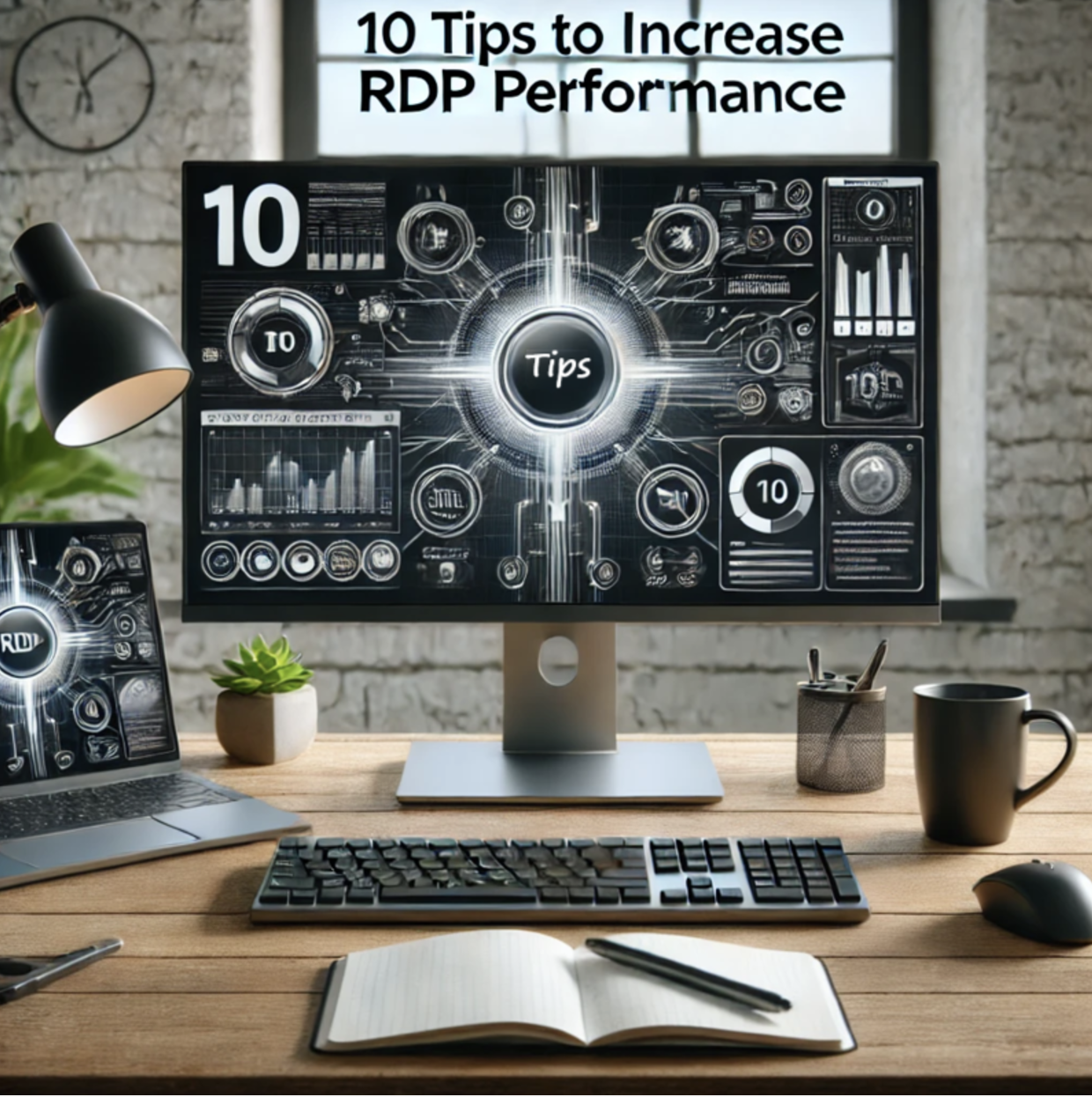Remote Desktop Protocol (RDP) performance refers to the efficiency and responsiveness of remotely accessing and controlling a computer.
This matters greatly in today’s fast-paced, interconnected world where professionals, IT administrators, and businesses rely on remote access to maintain productivity and efficiency.
Slow RDP connections can result in delays, reduced productivity, and frustration, especially for tasks involving graphics-intensive operations or live collaborations.
Optimizing RDP performance ensures smoother, faster, and more secure interactions, making it a crucial focus for remote workers, IT teams, and businesses scaling their digital infrastructure.
Also, you can get seamless performance with Admin RDP, ensuring speed, stability, and security for all your remote desktop needs.
RDP Performance; Impact Before and After Optimization
Before diving into this guide, check the below table, which highlights the tangible improvements in RDP performance by implementing the tips, showing how each optimization enhances your experience.
| Tip | Before Optimization | After Optimization |
| Optimize Network Connection | Slow, unstable connections, high latency | Stable, fast connections, minimal lag |
| Adjust RDP Client Settings | Laggy performance, poor image quality | Smoother, faster experience with reduced data load |
| Enable Compression in RDP | High data usage, slow image load times | Faster image rendering, less bandwidth consumption |
| Upgrade Your Hardware | Frequent delays, crashes, lag | Faster processing, smoother experience |
| Enable RemoteFX for Graphics | Poor video rendering, slow 3D graphics | Smooth, high-quality graphics for intensive tasks |
| Implement Network-Level Authentication (NLA) | Longer login times, less secure sessions | Faster login, more secure sessions |
| Monitor and Manage Network Resources | Network congestion, slow speeds | Optimized bandwidth usage, minimal disruption |
| Update Software and Drivers | Compatibility issues, performance issues | Seamless experience with the latest features and fixes |
| Choose Geographically Closer Servers | High latency, connection instability | Faster connections, reduced lag |
| Use Advanced Tools | Basic RDP features, limited functionality | Enhanced features, better performance, secure file transfer |
Unlock the Full Potential of Your RDP Connection
Stay with us to learn how to optimize every aspect of your remote desktop performance for a seamless experience. Explore these 10 actionable tips to maximize the speed, stability, and efficiency of your RDP sessions.

1. Optimize Network Connection
A fast and stable network is crucial for RDP performance. Ethernet connections offer lower latency compared to Wi-Fi, making them ideal for resource-heavy tasks. Regularly test speed and prioritize RDP traffic via router settings to maintain a reliable connection.
- Use an Ethernet cable and configure your router’s Quality of Service (QoS) settings to prioritize RDP traffic.
- Remote workers and IT professionals relying on high-bandwidth applications will see significant benefits.
2. Adjust RDP Client Settings
Fine-tuning your RDP client settings can reduce data load, improving performance. Lowering screen resolution, disabling font smoothing, and turning off audio redirection are all effective ways to lighten the session’s demand on bandwidth.
- In the “Experience” tab, reduce resolution, and disable non-essential features such as font smoothing and audio redirection.
- This is helpful for users on slow networks or with older hardware.
3. Enable Compression in RDP
Compression reduces the amount of data transferred during an RDP session, helping to speed up performance. By enabling bitmap caching, RDP will store commonly accessed images locally, reducing the need for repeated data transfers.
- Enable bitmap caching and compression in the “Display Options” or “Experience” section of your RDP client.
- IT teams managing remote connections or users on limited bandwidth should enable this feature.
4. Upgrade Your Hardware
Upgrading hardware can significantly improve RDP performance. Installing a faster CPU, more RAM, and an SSD can eliminate bottlenecks during remote sessions, providing a smoother experience.
- Upgrade the CPU, increase the RAM, and install an SSD for better processing speed. Ensure the remote machine has comparable hardware.
- Developers, designers, and professionals using resource-intensive applications remotely will benefit most.

5. Enable RemoteFX for Graphics
RemoteFX enhances graphical performance in RDP by using GPU acceleration, which is essential for 3D rendering and video playback tasks.
- Enable GPU virtualization and RemoteFX in the RDP settings of the remote machine.
- Multimedia professionals, designers, and engineers working with high-end graphic applications will benefit from this feature.
6. Implement Network-Level Authentication (NLA)
NLA improves security by authenticating users before establishing an RDP connection. It also reduces the server load during authentication, improving session startup speed.
- Enable NLA by selecting “Allow connections only from computers running NLA” in the remote system’s properties.
- System administrators and security-conscious users should prioritize enabling NLA.
7. Monitor and Manage Network Resources
Heavy network traffic can impact RDP performance. Using network monitoring tools like GlassWire can help track bandwidth consumption, and scheduling high-demand tasks for off-hours can alleviate congestion.
- Install network monitoring software and schedule bandwidth-heavy tasks for non-peak hours.
- Businesses or remote workers sharing networks will benefit from this tip for optimized performance.
8. Update Software and Drivers
Outdated software can cause compatibility issues, leading to slower RDP performance. Regular updates ensure you’re using the latest enhancements and security fixes, maintaining a smooth experience.
- Enable automatic updates for your RDP client, drivers, and system software, or check for updates regularly.
- Everyone, especially those working with older systems, should keep their software and drivers updated.
9. Choose Geographically Closer Servers
Selecting a server closer to your location reduces latency and improves RDP performance by shortening the data travel distance.
- Choose the nearest server location when setting up an RDP connection.
- Global teams and businesses with remote workers across different regions will benefit the most from this strategy.

10. Use Advanced Tools Like AnyViewer
Advanced tools like AnyViewer offer enhanced RDP performance, with features such as UHD support, high frame rates, and cross-device compatibility, ideal for businesses and power users.
- Install AnyViewer or similar tools to take advantage of features like optimized graphics, secure file transfer, and cross-platform compatibility.
- Businesses or advanced users managing multiple remote desktops will see improved performance using these tools.
RDP Tools and Software Comparison
| Tool/Software | Features | Pros | Cons |
| AnyViewer | UHD support, high frame rates, cross-platform | Superior remote access, enhanced file transfer | Paid plans are required for full features |
| Microsoft Remote Desktop | Basic RDP features, built-in to Windows | Free, straightforward to set up | Limited functionality compared to advanced tools |
| Chrome Remote Desktop | Cross-platform, simple setup | Free, easy to use | Requires Google account, less security options |
| TeamViewer | File transfer, remote access, cross-platform | User-friendly, secure connections | Paid subscription required for commercial use |
| AnyDesk | Low-latency, high-quality graphics | Fast and secure connections | The free version is limited in some features |
What is the ideal network speed for smooth RDP?
A minimum of 10 Mbps is recommended for a decent experience, though higher speeds are preferable for multimedia tasks.
How do I troubleshoot persistent RDP lag?
Identify issues by monitoring latency and packet loss using tools like PingPlotter. Adjust client settings or upgrade hardware as needed.
Why is my RDP session disconnecting frequently?
Frequent disconnections are often due to unstable networks or incorrect timeout settings on the remote server. Check your router and adjust RDP session timeout configurations.
How can I improve RDP connection speed?
To improve RDP speed, prioritize a stable Ethernet connection, enable compression in RDP settings, and optimize network resources by reducing bandwidth consumption during peak hours.

How does upgrading hardware affect RDP performance?
Upgrading to a faster CPU, more RAM, and an SSD can eliminate hardware bottlenecks, resulting in faster processing and smoother RDP sessions, especially for resource-heavy tasks.
Is RemoteFX important for RDP performance?
Yes, enabling RemoteFX significantly enhances graphical performance for 3D rendering or video playback by utilizing GPU acceleration, improving visual experience in remote desktop sessions.
How do I know if my RDP settings are optimized?
Test your RDP performance using tools like Speedtest and monitor your connection’s response time. Adjust settings such as resolution, compression, and hardware acceleration to ensure smooth remote access.
Conclusion
Optimizing RDP performance is crucial for ensuring smooth, efficient, and secure remote access to systems. By implementing tips like optimizing network connections, adjusting RDP settings, enabling compression, and upgrading hardware, users can significantly enhance their remote desktop experience.
These improvements are essential for IT professionals, remote workers, and businesses, especially those handling resource-intensive tasks or scaling their infrastructure.
With faster, more responsive RDP connections, teams can achieve higher productivity, avoid frustration, and maintain seamless workflow across distances, ultimately making RDP a powerful tool in today’s interconnected world.





